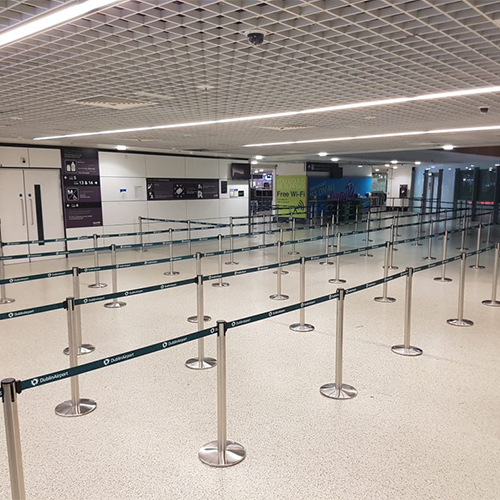
Table of Contents
Line Stanchions – A Buyers Guide
Line stanchions are also known as queueing stanchions or retracting belt barriers. The brilliantly simple idea of putting a car seat belt mechanism on top of a post and then joining the belts up to form a barrier was first conceived in the UK in the mid 70s. Since that time the line stanchion has become the standard product for forming waiting lines and can be seen in every type of public venue around the world.
Although the basic concept of the line stanchion remains unchanged, today there are dozens of brands and hundreds of models to choose from. So how do you decide which option best suits your needs? There are a few simple steps in the decision making process that will take you to the right decision
1. Economy or Premium?
The first cut in the stanchion selection process is to decide whether to opt for an economy or premium model. The base on an economy stanchion is a shell of galvanized steel filled with concrete. While this is a perfectly good solution for providing weight at the foot of the post to give stability the rim on this base type is likely to dent if the stanchion is dropped and that causes the stanchion to wobble. Spare parts are not typically available on economy models so if this happens the whole stanchion has to be replaced. Premium stanchions have cast iron bases that are virtually indestructible. So, although the economy model will have a lower purchase cost it will also have a shorter service life. A good quality economy stanchion is a perfectly acceptable choice if the stanchions are not going to be moved and will be used with light pedestrian traffic. But in heavy traffic areas or where the stanchions are moved to clean floors or change the queue layout a premium model give a better return on your investment.
2. How Many Belts?
Most line stanchions have one belt and that is perfectly sufficient to guide customers in to forming an orderly waiting line. However, in some circumstances twin belt stanchions are a better option and may actually be required. The primary purpose of a second belt, set in the middle of the stanchion, is to discourage customers from ducking under the belt. For many public venues compliance with the Americans with Disabilities Act is important. Single belt stanchions do not comply with ADA, but twin belts do as the lower belt can be detected by the visually impaired using a cane.
3. How Long?
It is surprising how rarely buyers fail to factor in belt length when making their purchase decision. Belt length is key when considering the price of a line stanchion. Put simply the longer the belt the fewer stanchions you need. Amongst the top brands in the US the standard belt length varies between 7’ and 11’, that’s a 57% difference! Choosing a longer belt means fewer stanchions to buy, faster set up time, less storage space and fewer maintenance costs. The quick way to calculate belt length into the purchase price is to divide the stanchion price by the belt length to give a price per foot of belt. For example, an $80.00 stanchion with a 7’ belt cost $11.42 per foot of queue, while an $80.00 stanchion with an 11’ belt only costs $7.27 per foot!
4. Customizing
Once the stanchion specification has been set the last consideration is customizing the stanchion. The most common form of customizing is belt printing. A line stanchion with an 11’ belt has almost 2 sq ft of belt area. This is prime advertising real-estate as it is in the most heavily traffic location in the venue, the customer queue. Belts are printed using the dye sublimation process which is a form of digital printing in which the ink is dyed into the fibers of the belt so it can never wear off. Being a digital process, anything can be printed, logos, photographs even scannable QR codes. If you do opt to utilize the promotional opportunity the stanchion belt provides consider upgrading to Queue Solutions’ unique 3” wide Xtra belt. Standard belts are 2” wide so the Xtra belt allow logos and messages to be printed 50% larger greatly increasing the visibility of the print.
Conclusion
Buying line stanchions need not be complicated. If you make the four key decisions; concrete or iron base, one, two or three belts, length of the belts and finally printing the belts you will then be able to ensure the competing quotes you get are for the same specification and that you are buying the product that is right for your application. One last reminder, when you compare those quotes don’t forget to use price per foot of belt as the true price comparison.


